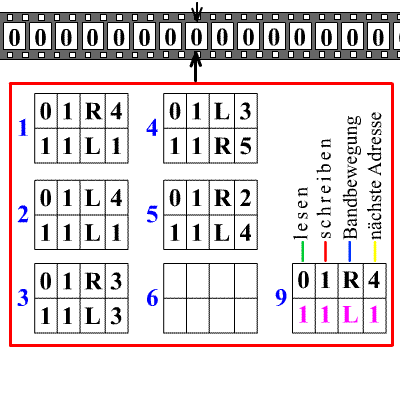Turing machine (nonfiction): Difference between revisions
No edit summary |
|||
| Line 35: | Line 35: | ||
* [[Quantum simulator (nonfiction)]] | * [[Quantum simulator (nonfiction)]] | ||
* [[Turing completeness (nonfiction)]] | * [[Turing completeness (nonfiction)]] | ||
* [[Universal Turing machine (nonfiction)]] | |||
External links: | External links: | ||
Revision as of 17:20, 18 May 2017
A Turing machine is a hypothetical device that manipulates symbols on a strip of tape according to a table of rules.
Despite its simplicity, a Turing machine can be adapted to simulate the logic (nonfiction) of any computer algorithm.
At a very high level, the machine consists of a memory tape divided into cells.
A "head" (e.g. a pencil/eraser) traverses the memory one cell at a time, writing or erasing data (e.g. numerical digits) based on user-specified rules.
The "machine" was invented in 1936 by Alan Turing (nonfiction) who called it an "a-machine" (automatic machine).
The Turing machine is not intended as practical computing technology, but rather as a hypothetical device representing a computing machine.
Turing machines help computer scientists understand the limits of mechanical computation.
Turing completeness (nonfiction) is the ability for a system of instructions to simulate a Turing machine.
A programming language that is Turing complete is theoretically capable of expressing all tasks accomplishable by computers.
In the News
Fiction cross-reference
Nonfiction cross-reference
- Alan Turing (nonfiction)
- Alonzo Church (nonfiction)
- Computer science (nonfiction)
- Mathematics (nonfiction)
- Quantum simulator (nonfiction)
- Turing completeness (nonfiction)
- Universal Turing machine (nonfiction)
External links:
- Turing machine @ Wikipedia
